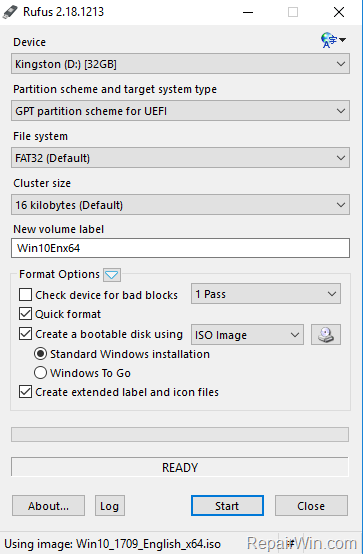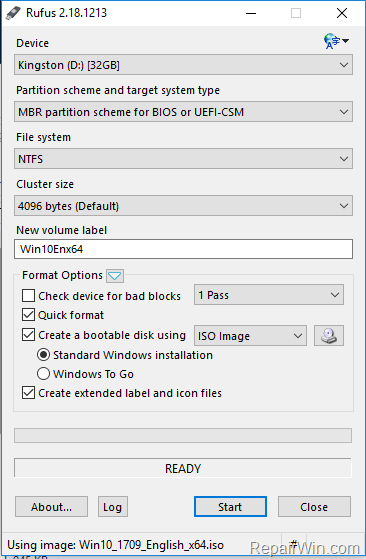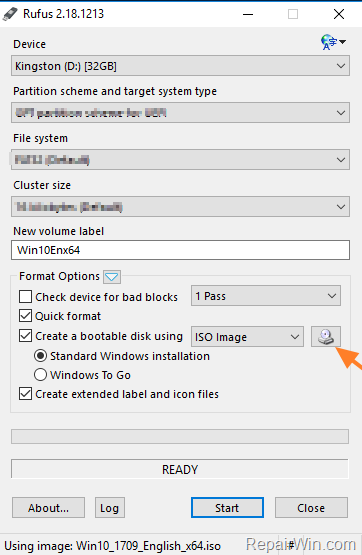Many laptops today doesn’t contain a CD/DVD ROM drive in their configuration or maybe the drive is damaged. In that cases, the only way to install or to repair Windows, is to use an external DVD drive or to use a Windows USB boot disk. If you don’t own a Windows USB boot disk, then you can create one by using Microsoft’s Media Creation Tool or the Rufus Creator utility.
In this tutorial you can find step by step instructions to create a Windows 10 USB Boot Drive from a Windows ISO file, using the RUFUS Creator Utility, in order to install or to repair Windows. You can use the same instructions to create a Windows 8/8.1 USB or a Windows 7 USB boot drive.
- Related article: How to create a Windows 10 USB installation media with the Media Creation Tool.
How to create a Windows USB Boot Drive From Windows ISO with Rufus utility.
To create a Windows USB bootable drive from a Windows ISO file:
1. Download the latest version of Rufus Creator Utility from http://rufus.akeo.ie/.
2. Plug an EMPTY USB flash drive on your computer.
3. Run “Rufus Creator Utility”
4. Choose the empty USB drive on the top. (Device).
5. Then specify in RUFUS options, in what system (UEFI or Legacy) you want to use the installation media and then continue to step (6).
- UEFI: If you want to use the Windows 10 installation media on a UEFI based System, set the following settings in RUFUS:
- Partition scheme and target system type: GPT partition scheme for UEFI. *
- File system: FAT32 (Default).
- Cluster size: 16 kilobytes (Default).

* Note: In order to boot from a UEFI USB flash drive, enter in BIOS setup and apply the following settings:
1. Set the Boot configuration to: UEFI
2. Temporarily Disable the Secure Boot mode until the Windows installation is completed.
3. Temporarily Disable the Fast Boot mode until the Windows installation is completed.
4. Boot Order: First Boot device = USB Hard Drive.
- Legacy: If you want to use the Windows 10 installation media on a MBR based System, set the following settings in RUFUS:
- Partition scheme and target system type: MBR partition scheme for BIOS or UEFI-CSM. *
- File system: NTFS.
- Cluster size: 4096 bytes (default).

* Note: In order to boot from a Legacy USB flash drive, you must apply these settings in BIOS:
1. Set the Boot configuration to: Legacy.
2. Disable the Secure Boot mode.
3. Boot Order: First Boot device = USB Hard Drive.
6. When done with the above settings, press the “Click to select image” icon.

7. Select the Windows ISO image file that you want to use from the media creation and click Open.

8. Finally click the Start button to create the Windows 10 USB installation and recovery media.
That’s all folks! Did it work for you?
Please leave a comment in the comment section below or even better: like and share this blog post in the social networks to help spread the word about this.
Bài liên quan
- FIX: Error 0x81000203 in System Restore. (Solved)
- Cannot Access Shared folder. User has not been granted the requested logon type at this computer. (Solved)
- FIX: Cannot clear TPM – 0x80284001, 0x80290300 or 0x80290304.
- Unable to Schedule Teams Meeting in 15 or 10 minutes slots (Solved)
- How to Share Folder without Username/Password on Windows 10/11.
- FIX: Thunderbird High CPU or Memory Usage issues.

